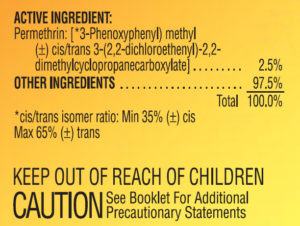07
Mar
Common Household Pesticides Again Linked to Behavioral Problems in Children
(Beyond Pesticides, March 7, 2017) Another study, published by a team of French scientists in the journal Occupational and Environmental Medicine, links childhood behavioral problems to pyrethroid insecticide exposure. Synthetic pyrethroids are a class of insecticides that have increased in use over the past decade due to assumptions that they pose fewer risks to human health than older pesticide chemistries, such as organophosphates. However, this latest study is part of a growing body of research showing that pyrethroids share similar neurocognitive health concerns as these older pesticides.
.
In this research, scientists investigate the interplay between pyrethroid exposure and behavioral problems through a longitudinal cohort study, which tracks levels of pyrethroid metabolites, or breakdown products, in the urine of mothers beginning between six and 19 gestational weeks and then in their children up through six years of age. Children’s behavior is measured through a screening questionnaire known as the Strengths and Difficulties Questionnaire (SDQ). SDQ measures how social a child is (altruism), whether the child has difficulty sharing problems or asking for help (internalizing disorders), as well as how defiant or disruptive a child is (externalizing disorders).

The study controlled for a number of confounding factors, such as weight, education, location (rural or urban), fish consumption, breastfeeding, home tobacco use, number of siblings, average sleep duration, as well as time spent on television and video game play, participation in extra-curricular sports, and exposure to lead. Most of the children studied attended nursery school, lived in a non-spoking environment, slept at least 10.5 hours per day, and participated in extra-curricular sports.
Pyrethroid metabolites were regularly detected in both mothers and children participating in the study. Internalizing disorders were associated with high levels of a certain pyrethroid metabolite (cis-DCCA, a breakdown product of permethrin, cypermethrin, and clyfluthrin) in pregnant mother’s urine. Externalizing disorders were associated with pyrethriod metabolites in general (3-PBA, a breakdown product not specific to one particular pyrethroid) in children’s urine samples. Researchers hypothesize that the behavioral disorders are rooted in changes to a child’s brain. Because pyrethroids act on sodium channels, increased sodium influx may result in impacts to synaptic plasticity, which is important in the development of learning and memory. Scientists infer that pyrethroid exposure may also alter the transport of dopamine throughout the brain. The authors note in conclusion, “The current study suggests that exposure to certain pyrethroids at the low environmental doses encountered by the general public may be associated with behavioural disorders in children.”
The results of this research reinforce another study published in 2015 by doctors at Cincinnati Children’s Hospital Medical Center, which finds an association between pyrethroid exposure and ADHD hyperactivity and impulsivity in adolescent boys. Further, another 2015 study by a consortium of scientists led by a Rutgers University research team finds associations between the synthetic pyrethroid deltamethrin and ADHD. Other recent research on pyrethroids and children have found significant neutoxicity concerns. University of California Davis’ long-running CHARGE study investigating childhood autism risks determined that living near a farm field where pyrethroids are applied during a mother’s third trimester corresponds with an 87% increased risk of having a child with autism.
As more and more synthetic pyrethroids are sold to consumers with claims that they are lower toxicity or as safe as chrysanthemum flowers, the chemicals are showing up in increasing concentrations in children’s urine, as reported by recent research at University California, Davis. In addition to their use in home pest control in products like RAID®, they are commonly found in head lice shampoos marketed for children, despite studies indicating that 99.6% of lice are resistant to treatment by the commonly used synthetic pyrethroid permethrin.
Notwithstanding these concerns, there are fortunately some simple steps parents can take to eliminate their child’s exposure to pyrethroids and toxic pesticides in general. First is to employ least-toxic methods of controlling pests in and around the home. For nearly every pest problem one encounters in the modern world, there are viable alternatives to the use of synthetic insecticides like pyrethroids. Beyond Pesticides ManageSafe tool provides a step-by-step guide to help individuals manage pests, from cockroaches, to bed bugs, head lice, and ants.
In considering a range of exposure pathways, parents should strongly consider ways to increase consumption of organic foods in their child’s diet. A number of studies have found that children who switch from a conventional-based to an organic diet see significant drops in levels of pesticides measured in their urine. In addition to implementing safer measures around one’s home, Beyond Pesticides strongly encourages concerned parents to become active in their community against toxic pesticides. By advocating for community change that eliminates regular use of toxic pesticide use in schools, playgrounds, and other public places where children learn and play, communities can achieve significant advances in protecting public health. If you would like to Start Your Own Local Movement, reach out to Beyond Pesticides at [email protected] or 202-543-5450.
Source: Journal of Occupational and Environmental Medicine
All unattributed positions and opinions in this piece are those of Beyond Pesticides.










